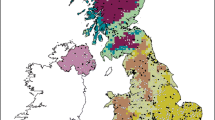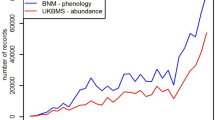Abstract
Data from the Greater Manchester Butterfly Atlas (UK) reveal a highly significant and substantial impact of visits on both species' richness and species' incidence in squares. This effect has been demonstrated for three different zones mapped at different scales. The significant impact of number of visits persists when data are amalgamated for coarser scales. The findings demonstrate that it is essential for distribution mapping projects to record data on recording effort as well as on the target organisms. Suggestions are made as to how distribution mapping may be improved, including a geographically and environmentally representative structure of permanently monitored squares and closer links between distribution mapping and the Butterfly Monitoring Scheme (BMS), which primarily monitors changes in butterfly populations. The benefit to conservation will be data that can be better used to analyse the reasons for changes in ranges and distributions, fundamental for determining priorities and policy decisions.
Similar content being viewed by others
References
Asher, J. (1995) Butterfly Net. Butterfly Conservation News 60, 15.
Asher, J. (1997) Butterflies for the New Millennium - project and programme. In Butterflies for the New Millennium (R. Fox, ed). pp. 20–21. Proceedings of the 3rd Annual Meeting at Doncaster, May 1997. Huntingdon: ITE Monks Wood.
Dennis, R.L.H. (1993) Butterflies and climate change. Manchester: Manchester University Press.
Dennis, R.L.H. and Williams, W.R. (1986) Butterfly ‘diversity’. Regressing and a little latitude. Antenna, 10, 108–112.
Emmet, M. and Heath, J. (1990) The butterflies of Great Britain and Ireland. Colchester: Harley Books.
Fox, R. (ed) (1997) Butterflies for the New Millennium. Proceedings of the 3rd Annual Meeting at Doncaster, May 1997. Monks Wood, Huntingdon: ITE.
Harding, P.T. (1997) Why ITE is supporting the Butterflies for the New Millennium Project. In Butterflies for the New Millennium (R. Fox, ed). pp. 4–6. Proceedings of the 3rd Annual Meeting at Doncaster, May 1997. Huntingdon: Monks Wood ITE.
Hardy, P.B. (1998) Butterflies of Greater Manchester. Sale: PGL Enterprises.
Heath, J., Pollard, E. and Thomas, J.A. (1984) Atlas of Butterflies in Britain and Ireland. London: Viking.
Pollard, E. and Yates, T.J. (1993) Monitoring butterflies for ecology and conservation. London: Chapman and Hall.
Prendergast, J.R. and Eversham, B.C. (1995) Butterfly diversity in southern Britain: hotspot losses since 1930. Biological Conservation 72, 109–114.
Quinn, R.M., Gaston, K.J. and Roy, D.B. (1997) Coincidence between consumer and host occurrence: macrolepidoptera in Britain. Ecol. Entomol. 22, 197–208.
Rich, T. (1998) Squaring the circles - bias in distribution maps. British Wildlife 9, 213–219.
Shreeve, T.G. (1992) Monitoring butterfly movements. In R.L.H. Dennis (ed.) The Ecology of Butterflies in Britain. Oxford: Oxford University Press.
Sokal, R.R and Rohlf, F.J. (1995) Biometry. New York: W.H. Freeman and company.
Sparks, T.H., Dover, J.W., Warren, M.S. and Cox, R. (1995) How well can we model the distribution of butterflies at the landscape scale? In Landscape ecology: theory and application (G.H. Griffiths, ed.). pp. 24–31. Aberdeen: IALE (UK).
Statistica (1994) STATISTICA for Windows I-III. Tulsa, OK: Statsoft, Inc.
Thomas, C.D. and Abery, J.C.G. (1995) Estimating rates of butterfly decline from distribution maps: the effects of scale. Biol. Conserv. 73, 59–65.
Thomas, C.D., Thomas, J.A. and Warren M.S. (1992) Distributions of occupied and vacant habitats in fragmented landscapes. Oecologia 92, 563–567.
Vickery, M.L. (1995) Gardens: the neglected habitat. In Ecology and conservation of butterflies (A.S. Pullin, ed.). pp. 123–134. London: Chapman and Hall.
Warren, M.S., Barnett, L.K., Gibbons, D.W. and Avery, M.I. (1997) Assessing national conservation priorities: an improved red list of British butterflies. Biol. Conservation 82, 317–328.
Author information
Authors and Affiliations
Rights and permissions
About this article
Cite this article
Dennis, R.L., Sparks, T.H. & Hardy, P.B. Bias in Butterfly Distribution Maps: The Effects of Sampling Effort. Journal of Insect Conservation 3, 33–42 (1999). https://doi.org/10.1023/A:1009678422145
Issue Date:
DOI: https://doi.org/10.1023/A:1009678422145




